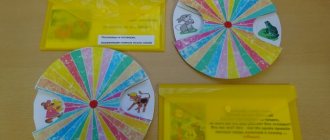Conversation as a method of developing dialogue speech
Definition 1
A conversation is a purposeful discussion of something; organized and prepared dialogue on a pre-selected topic.
Conversation is considered in preschool pedagogy as a method of getting to know the world around us and at the same time as a method of developing coherent speech. Radina E.I. in her research she revealed in detail the importance of conversation in the mental and moral education of children. Some conversations can systematize and clarify the ideas that the child received in the course of his daily life, as a result of observation and activity. Other conversations help the child to perceive reality more deeply and fully, to clarify what they are not sufficiently aware of. As a result, children's knowledge becomes clearer and more meaningful.
Are you an expert in this subject area? We invite you to become the author of the Directory Working Conditions
The value of the conversation lies in the fact that during its course the adult teaches children logical thinking. In conversations, children must recall information, analyze it, compare it, make judgments and draw conclusions and conclusions. Along with thinking in conversations, speech also develops.
When expressing his thoughts in a conversation, the child formulates them not in one, but in several sentences. Educational issues require a more detailed description of what was seen and experienced, encouraging the expression of assessments and a personal attitude to the topic under discussion.
Note 1
The content of the conversation with preschool children is program material aimed at familiarizing children with the world around them, that is, the life and work of people, events in public life, and the activities of children in kindergarten.
The content of the conversation should be pedagogically justified, solve the problems of comprehensive education, accessible and psychologically close to preschoolers. Conversations flow lively and naturally, hold children’s attention, and activate their thinking if the program material is understandable and close to the experience the children have gained.
Finished works on a similar topic
Course work Conversation as a method of teaching dialogic speech to children of senior preschool age 450 ₽ Abstract Conversation as a method of teaching dialogical speech to children of senior preschool age 220 ₽ Test paper Conversation as a method of teaching dialogic speech to children of senior preschool age 220 ₽
Receive completed work or specialist advice on your educational project Find out the cost
The topics of the conversations are determined by the specific tasks of educational work with children, their age characteristics, the stock of knowledge that was acquired on excursions and during observations, as well as their immediate environment. The role of conversation can be fulfilled if it is based on other methods of getting to know the surrounding reality - excursions, walks, observations, if children have knowledge and experience that require streamlining.
Hill (1986) identifies five types of interpretation:
1. Establishing connections between seemingly separate statements, problems or events. For example, to a client who talks about fear of public speaking, low self-esteem and difficulties in relationships with other people, the consultant points out the interconnection of problems and the influence of the client’s inadequate expectations and claims on their occurrence.
2. Emphasizing any features of the client’s behavior or feelings. A client, for example, constantly refuses to work, although he expresses a desire to work. The counselor might tell him, “You seem to be excited about the opportunity, but when you encounter inevitable difficulties, you run away.”
3. Interpretation of methods of psychological defense, reactions of resistance and transference. In the above example, a possible interpretation is: “Judging by our conversation, running away is a way for you to deal with the fear of failure.” Thus, psychological defense (escape) from anxiety (fear of failure) is interpreted here. Transference interpretation is a fundamental technique in psychoanalytic treatment. They try to show the client that his past relationship (usually with his father or mother) prevents him from correctly perceiving the feelings and behavior of the consultant.
4. Linking current events, thoughts and experiences with the past. In other words, the consultant helps the client to see the connection between current problems and conflicts with previous psychological traumas.
5. Giving the client another opportunity to understand his feelings, behavior or problems.
In almost all of the listed types of interpretations, the moment of explanation is obvious, i.e. The essence of interpretation is to make the incomprehensible understandable. Let us give as an example an explanation to a client of the concept of “agoraphobia” (Storr A., 1980):
“From your story it follows that the world has become dangerous for you since childhood, when your mother was afraid to let you leave the house alone. Such fear is not surprising for a three-year-old child, but over the years, self-confidence and risk-taking increases. The only abnormality of your fear is its duration.”
This interpretation does not relieve the neurotic symptom, but it reduces anxiety, transforming the symptom from an incomprehensible obstacle into a clearly established problem that can be solved.
Interpretation should be carried out taking into account the stage of the consultative process. This technique is of little use at the beginning of counseling, when it is expected to achieve trusting relationships with clients, but later it is very useful for revealing the psychodynamics of problems.
The effectiveness of interpretation largely depends on its depth and time. A good interpretation usually doesn't go too deep. It must connect to what the client already knows. The effectiveness of the interpretation is also determined by the timeliness and the client’s willingness to accept it. No matter how wise and accurate the interpretation may be, if it is presented at the wrong time, the effect will be zero, since the client will not be able to understand the consultant's explanations.
The effectiveness of interpretation also depends on the client’s personality. According to S. Spiegel and C
Hill (1989), clients with high levels of self-esteem and education are more sensitive to interpretations and even in case of disagreement take them into account
The consultant must be able to understand clients' reactions to the essence of interpretations. The client's emotional indifference should force the consultant to think about the consistency of the interpretation with reality. However, if the client reacted with hostility and immediately rejected the interpretation as implausible, there is reason to assume that the interpretation has touched the root of the problem.
Classification of types of conversation
Flerina E.A. developed a classification of types of conversation based on didactic tasks. Thus, she distinguishes three types of conversation:
- introductory, which organizes children for a certain type of activity;
- accompanying children's activities and observations of children;
- the final one, designed to clarify and expand the children's experience.
Each type of conversation is unique in its purpose and method. The basis of this classification is the interaction of childhood experience and its expression in speech.
Konina M.M. Two types of conversations are identified that complement Flerina’s classification; they are based on the material in connection with which the conversation is conducted.
In terms of content, cognitive conversations are conventionally distinguished, for example, about school or hometown, and ethical conversations - about the norms and rules of behavior of people at home and in society.
Bibliography
1. Conversation method in psychology: A textbook for university students / Editor-compiler A.M. Aylamazyan. - M.: Smysl, 1999. - 222 p.
2. Ilyin E.P. Psychology of trust. - M.: Peter, 2013.
3. May R. The Art of Psychological Counseling /Trans. from English T.K. Kruglova. - M.: Nezavisimaya, 2000 - 124 p.
4. Nemov R.S. Fundamentals of psychological counseling: Textbook. for students pedagogical universities. — M.: Humanite. ed. VLADOS center, 1999. - 394 pp.
5. Borozdina G.V. Psychology of business communication: Textbook. - M.: INFRA-M, 2005 - 295 p.
6. Kociunas R. Fundamentals of psychological counseling. - M.: Academic project, 1999. - 240 p.
7. Molden D. “Management and the art of NLP.” - M., 1997
8. Minikes L. The Art of Business Communication, article 2004.
Posted on Allbest.ru
Conversation Tools
The ability to conduct a conversation and enter into dialogue with other people is an important factor in the process of socialization. From childhood, a person learns to express thoughts and convey his point of view to his interlocutor, listen to his partner and analyze what is said.
As a rule, during everyday informal conversation, an adult does not think about the means of conversation and uses them automatically. However, the effectiveness of the conversation largely depends on how consciously and thoughtfully they are used. Such means include:
- asking questions;
- listening to the interlocutor;
- studying the interlocutor’s reactions;
- transfer of information to the interlocutor.
Statement of a question
A poorly posed question can lead to the fact that the interlocutor does not want to enter into a conversation or will try to end it as quickly as possible
Therefore, it is important for the questioner to take into account the atmosphere between people, the mood of the partner and the timeliness of the question. There are several rules that will help you formulate the question correctly:
- Ask open-ended questions so that the person can give a detailed answer.
- Don't ask too long questions.
- Avoid double questions (or... or...).
- Questions should not be forced or suggestive of an answer.
- Each question should be related to the topic being discussed and pursue a goal.
- After asking a question, pause to give your interlocutor time to think.
Listening to your interlocutor
In conversation, in addition to mastering conversation skills, it is important to be a good listener. The interlocutor must see that you are really interested in what he is talking about
In addition, the ability to listen makes the cognition process more effective and increases a person’s tendency to empathize. To do this you need to follow the rules:
- Use the word “I” less often in your speech.
- Encourage people to talk about themselves.
- Ask leading questions.
- Show interest through nonverbal signs.
- Don't get distracted while talking.
- Look at your interlocutor.
Studying the interlocutor's reactions
This tool allows you to manage the conversation and ensure that the atmosphere remains relaxed
At the same time, it is important to study not only the personality traits of the interlocutor, but also dynamic manifestations - mood, motives, intentions, position taken, behavioral attitudes, etc. Observation during a conversation helps to monitor the interlocutor’s reaction and, if necessary, move the conversation to other topics in a timely manner
Conversation structure
The stages of the conversation are not strictly limited; each of them can gradually move into the next one or be planned:
Introductory part. Plays a role in creating an atmosphere of conversation and creating an appropriate mood for the interlocutor
It is necessary to indicate the importance of the respondent’s participation in the conversation, arouse his interest, and communicate the goals of the results. In addition, you need to indicate the time of testing, whether the survey will be the only one with this person, and mention the guarantee of confidentiality. Second phase
Identification of questions that elicit maximum free expression from the interlocutor on a given topic. Third stage. Its task is to conduct a detailed study of the issues under discussion by moving from general to specific issues. The most difficult and active stage is the culmination of the conversation, during which the psychologist must listen, observe, ask questions, maintaining the conversation in the right direction. The final stage. Attempts are made to ease tension and express gratitude for participation.
Stages of a conversation
Drawing up a plan for the upcoming communication (collect information about the profession, communicative qualities of the interlocutor; find out the interlocutor’s attitude to the issues that will be discussed; the topic must be clearly defined and acceptable to the interlocutor; for the experimenter himself it is necessary to clearly find out what he wants to achieve during the conversation, what pursues a goal; the questions of the conversation should be thought out, but not strictly defined).
- Creating external conditions to facilitate contact (think about where you and your interlocutor are sitting).
- Establishing contact.
- Adaptation. In the process of adaptation, the following points are highlighted: a) personal adaptation (to the one with whom the conversation is being conducted, cognition and adaptation); b) situational adaptation (getting used to the conditions, subject and purpose of communication); c) social adaptation (awareness and adaptation to a new social role in communication).
- Monitoring the mental state of the interlocutor and his attitude towards the beginning of communication (how he behaves).
- Actions to eliminate obstacles that arise in communication (incomplete psychological adaptation; negative attitude of the interlocutor toward contact; the presence of mental states that make communication difficult (anger, grief, excitement).
- Analysis after the conversation.
Tips and tricks
- It is necessary to prepare questions in advance on the problem under study, their formulation should be clear and understandable, taking into account the level of competence of the subject, and the questions should encourage a detailed answer.
- It is worth choosing the right questions, taking into account the mood and subjective attitude of the respondent during the conversation.
- It is recommended to start the conversation with an abstract topic, gradually moving on to the planned one.
- Showing goodwill towards the words of the interlocutor and genuine interest (pauses, asking again, “echo”, self-perception, i.e. active listening) inspire the trust of the respondent, which allows you to obtain the most reliable data.
- Be sure to conduct the study in a calm state. The interlocutor will feel the excited state and turn it on himself, which reduces the effectiveness of the entire conversation.
- It is recommended to find out in advance what environment and time will be most comfortable for the subject in order to effectively conduct the study.
From all of the above, we can conclude that conversation is one of the fundamental and effective research methods in psychology; it is used to obtain the most complete information about the subject through a combination of verbal and nonverbal forms of communication.
But along with the many advantages of this method, there is one major drawback - the professionalism of the researcher. It is necessary to be able to organize a conversation, taking into account all the details: the character and mood of the subject at the time of communication, the situation, the correct questions; the skill of “reading” and comparing verbal and non-verbal signals is also required. Only if the specialist has a high level of competence can the desired result be achieved during the research process.




